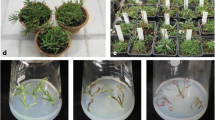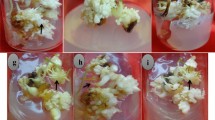Abstract
The callus of Pteris vittata was induced from gametophytes generated from spores in vitro, and grew rapidly with periodical medium change. Arsenic tolerance and accumulation of P. vittata callus were compared with those of Arabidopsis thaliana callus. Cell death was not detected in P. vittata callus even at arsenate concentrations up to 2 mM; however, A. thaliana callus died at low (0.2 mM) arsenate concentrations. Meanwhile, P. vittata callus accumulated almost three times more As than A. thaliana callus when exposed to 0.2 mM arsenate. About 60% of the total As was removed when 7.5 g of P. vittata callus was cultured on 150 ml of half-strength MS liquid medium containing 450 μg As for 2 days. Furthermore, P. vittata callus, sporophytes, and gametophytes all grew well under 1 mM of arsenate and accumulated 1,250; 1,150 and 2,180 mg kg−1 dry weight As when grown on 2 mM arsenate for 15 or 30 days. The characteristics of non-differentiated cells, large biomass, ease of culture, good synchronization, and excellent As sequestering, make the callus of P. vittata a new ideal system to study the mechanisms of As hyperaccumulation and phytoremediation in As-contaminated groundwater.







Similar content being viewed by others
Abbreviations
- As:
-
Arsenic
- MS:
-
Murashige and Skoog
- DW:
-
Dry weight
- FW:
-
Fresh weight
References
Anirudhan TS, Unnithana MR (2007) Arsenic(V) removal from aqueous solutions using an anion exchanger derived from coconut coir pith and its recovery. Chemosphere 66:60–66
Baker CJ, Mock NM (1994) An improved method for monitoring cell death in cell suspension and leaf disc assays using Evans blue. Plant Cell Tiss Org Cult 39:7–12
Byrne TE, Caponetti JD (1992) Morphogenesis in three cultivars of Boston fern. II. Callus production from stolon tips and plantlet differentiation from callus. Am Fern J 82:1–11
Cao XD, Ma LQ, Tu C (2004) Antioxidative responses to arsenic in the arsenic hyperaccumulator Chinese brake fern (Pteris vittata L.). Environ Pollut 128:317–325
Chattopadhyay S, Bhaumik S, Purkayastha M, Basu S, Nag Chaudhuri A, Das Gupta S (2002) Apoptosis and necrosis in develo** brain cells due to arsenic toxicity and protection with antioxidants. Toxicol Lett 136:65–76
Chen TB, Wei CY, Huang QF, Lu QG, Fan ZL (2002) Arsenic hyperaccumulator Pteris vittata L. and its arsenic accumulation. Chin Sci Bull 47:902–905
Chen S, Vaghchhipawala Z, Li W, Asard H, Dickman MB (2004) Tomato phospholipid hydroperoxide glutathione peroxidase inhibits cell death induced by Bax and oxidative stresses in yeast and plants. Plant Physiol 135:1630–1641
Duan GL, Zhu YG, Tong YP, Cai C, Kneer R (2005) Characterization of arsenate reductase in the extract of roots and fronds of Chinese brake fern, an arsenic hyperaccumulator. Plant Physiol 138:461–469
EC (1998) European Commission Directive, 98/83/EC, related with drinking water quality intended for human consumption. Brussels
Ellis DR, Gumaelius L, Indriolo E, Pickering IJ, Banks JA, Salt DE (2006) A novel arsenate reductase from the arsenic hyperaccumulating fern Pteris vittata. Plant Phyisol 141:1544–1554
EPA (2002) Environmental Protection Agency, Office of groundwater and drinking water. Implementation guidance for the arsenic rule. EPA Report 816-D-02-005, Cincinnati
Ghimire KN, Inoue K, Makino K, Miyajima T (2002) Adsorptive removal of arsenic using orange juice residue. Sep Sci Technol 37:2785–2799
Gopal K, Srivastava SB, Shukla S, Bersillon JL (2004) Contaminants in drinking water and its mitigation using suitable adsorbents: an overview. J Environ Biol 25:469–475
Gumaelius L, Lahner B, Salt DE, Banks JA (2004) Arsenic hyperaccumulation in gametophytes of Pteris vittata: a new model system for analysis of arsenic hyperaccumulation. Plant Physiol 136:3198–3208
Hayashi M, Takahashi H, Tamura K, Huang J, Yu LH, Kawai-Yamada M, Tezuka T, Uchimiya H (2005) Enhanced dihydroflavonol-4-reductase activity and NAD homeostasis leading to cell death tolerance in transgenic rice. Proc Natl Acad Sci USA 102:7020–7025
Huang JW, Poynton CY, Kochian LV, Elless MP (2004) Phytofiltration of arsenic from drinking water using arsenic-hyperaccumulating ferns. Environ Sci Technol 38:3412–3417
Iriti M, Sironi M, Gomarasca S, Casazza AP, Soave C, Faoro F (2006) Cell death-mediated antiviral effect of chitosan in tobacco. Plant Physiol Biochem 44:893–900
Jones JB Jr, Case VV (1990) Sampling, handling, and analyzing plant tissue samples. In: Westerman RL (eds) Soil testing and plant analysis, 2nd edn. Soil Science Society of America, Madison, pp 389–427
Joyce SM, Cassells AC, Jain SM (2003) Stress and aberrant phenotypes in in vitro culture. Plant Cell Tiss Org Cult 74:103–121
Kaise T, Watanabe S, Itoh K (1985) The acute toxicity of arsenobetaine. Chemosphere 14:1327–1332
Kwa SH, Wee YC, Loth CS (1991) Production of aposporous gametophytes and calli from Pteris vittata L. pinnae strips cultured in vitro. Plant Cell Rep 10:392–393
Lombi E, Zhao FJ, Fuhrman M, Ma L, McGrath SP (2002) Arsenic distribution and speciation in the fronds of the hyperaccumulator Pteris vittata. New Phytol 156:195–203
Lynn S, Gurr JR, Lai HT, Jan KY (2000) NADH oxidase activation is involved in arsenite-induced oxidative DNA damage in human vascular smooth muscle cells. Circ Res 86:514–519
Ma LQ, Komar KM, Tu C, Zhang W, Cai Y, Kennelley ED (2001) A fern that hyperaccumulates arsenic. Nature 409:579
Meharg AA, Hartley-Whitaker J (2002) Arsenic uptake and metabolism in arsenic resistant and nonresistant plant species. New Phytol 154:29–43
Mur LA, Kenton P, Atzorn R, Miersch O, Wasternack C (2006) The outcomes of concentration-specific interactions between salicylate and jasmonate signaling include synergy, antagonism, and oxidative stress leading to cell death. Plant Physiol 140:249–262
Namasivayam C, Holl WH (2005) Quaternised biomass as an anion exchanger for the removal of nitrate and other anions from water. J Chem Technol Biotechnol 80:164–168
Nriagu JO (2002) Arsenic poisoning through the ages. In: Frankenberger WT (ed) Environmental chemistry of arsenic. Marcel Dekker, New York, pp. 1–26
Payne RW (2002) The Guide to GenStat Release 6.1-Part 1: Syntax and Data Management, GenStat Committee, VSN International, Hemel Hempstead
Rakotoarison DA, Gressier B, Trotin F, Brunet C, Dine T, Luyckx M, Vasseur J, Cazin M, Cazin JC, Pinkas M (1997) Antioxidant activities of polyphenolic extracts from flowers, in vitro callus and cell suspension cultures of Crataegus monogyna. Pharmazie 52:60–64
Rathinasabapathi B, Wu S, Sundaram S, Rivoal J, Srivastava M, Ma LQ (2006) Arsenic resistance in Pteris vittata L.: identification of a cytosolic triosephosphate isomerase based on cDNA expression cloning in Escherichia coli. Plant Mol Biol 62:845–857
Salt DE, Smith RD, Raskin I (1998) Phytoremediation. Annu Rev Plant Physiol Plant Mol Biol 49:643–648
Singh N, Ma LQ, Srivastava M, Rathinasabapathi B (2006) Metabolic adaptations to arsenic-induced oxidative stress in Pteris vittata L and Pteris ensiformis L. Plant Sci 170:274–282
Smith E, Naidu R, Alston AM (1998) Arsenic in the soil environment: a review. Adv Agron 64:149–195
Srivastava M, Ma LQ, Singh N, Singh S (2005) Antioxidant responses of hyper-accumulator and sensitive fern species to arsenic. J Exp Bot 415:1335–1342
Tamas L, Budikova S, Huttova J, Mistrik I, Simonovicova M, Siroka B (2005) Aluminum-induced cell death of barley-root border cells is correlated with peroxidase- and oxalate oxidase-mediated hydrogen peroxide production. Plant Cell Rep 24:189–194
Tsao DT (2003) Overview of phytotechnologies. In: Tsao DT (ed) Phytoremediation. Springer, Berlin, pp 1–46
Tu S, Ma LQ (2004) Comparison of arsenic and phosphate uptake and distribution in arsenic hyperaccumulating and nonhyperaccumulating fern. J Plant Nutr 27:1227–1242
Tu C, Ma LQ, Bondada B (2001) Arsenic accumulation in the hyperaccumulator Chinese brake and its utilization potential for phytoremediation. J Environ Qual 31:1671–1675
Tu S, Ma LQ, Fayiga AO, Zillioux EJ (2004a) Phytoremediation of arsenic-contaminated groundwater by the arsenic hyperaccumulating fern Pteris vittata L. Int J Phytoremediation 6:35–47
Tu S, Ma LQ, MacDonald GE, Bondada B (2004b) Effects of arsenic species and phosphorus on arsenic absorption, arsenate reduction and thiol formation in excised parts of Pteris vittata L. Environ Exp Bot 51:121–131
Wang J, Zhao FJ, Meharg AA, Raab A, Feldmann J, McGrath SP (2002), Mechanisms of arsenic hyperaccumulation in Pteris vittata. Uptake kinetics, interactions with phosphate, and arsenic speciation. Plant Physiol 130:1552–1561
WHO (2001) Arsenic compounds, environmental health criteria, 2nd edn. World Health Organisation, Geneva
Woo SH, Park IC, Park MJ, Lee HC, Lee SJ,Chun YJ, Lee SH, Hong SI, Rhee CH (2002) Arsenic trioxide induces apoptosis through a reactive oxygen species-dependent pathway and loss of mitochondrial membrane potential in HeLa cells. Int J Oncol 21:57–63
Wright KM, Duncan GH, Pradel KS, Carr F, Wood S, Oparka KJ, Cruz SS (2000) Analysis of the N gene hypersensitive response induced by a fluorescently tagged tobacco mosaic virus. Plant Physiol 123:1375–1386
Yoshihara T, Tsunokawa K, Miyano Y, Arashima Y, Hodoshima H, Shoji K, Shimada H, Goto F (2005) Induction of callus from a metal hypertolerant fern, Athyrium yokoscense, and evaluation of its cadmium tolerance and accumulation capacity. Plant Cell Rep 23:579–585
Zhang WH Cai Y, Tu C, Ma LQ (2002) Arsenic speciation and distribution in an arsenic hyperaccumulating plant. Sci Tot Environ 300:167–177
Zhang WH, Cai Y, Downum KR, Ma LQ (2004a) Arsenic complexes in the arsenic hyperaccumulator Pteris vittata (Chinese brake fern), J Chromatogr A 1043:249–254
Zhang WH, Cai Y, Downum KR, Ma LQ (2004b) Thiol synthesis and arsenic hyperaccumulation in Pteris vittata (Chinese brake fern). Environ pollut 131:337–345
Zhao FJ, Wang JR, Barker JHA, Schat H, Bleeker PM, McGrath SP (2003) The role of phytochelatins in arsenic tolerance in the hyperaccumulator Pteris vittata. New Phytol 159:403–410
Acknowledgments
This work was supported by the National Science Foundation Council of China (Grant no. 30370127, 30500307 and 30670171).
Author information
Authors and Affiliations
Corresponding author
Additional information
Communicated by L. Peña.
Rights and permissions
About this article
Cite this article
Yang, X., Chen, H., Xu, W. et al. Hyperaccumulation of arsenic by callus, sporophytes and gametophytes of Pteris vittata cultured in vitro . Plant Cell Rep 26, 1889–1897 (2007). https://doi.org/10.1007/s00299-007-0388-6
Received:
Revised:
Accepted:
Published:
Issue Date:
DOI: https://doi.org/10.1007/s00299-007-0388-6




